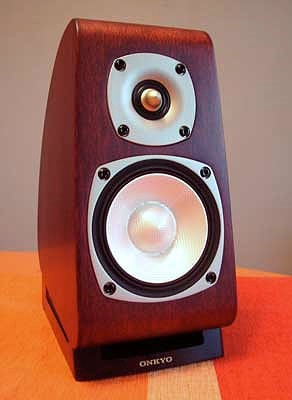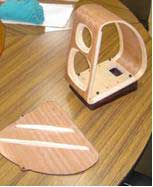|
|

|
Specifications:
-
Design: 2-way Bass Reflex
-
Drivers: One 1" Tweeter, One 4" Woofer
-
MFR: 50 Hz - 100 kHz
-
Crossover Frequency: 3.5 kHz
-
Sensitivity: 80 dB
-
Nominal Impedance: 4 Ohms
-
Dimensions: 10.8" H x 5.3" W x 8.9" D
-
Weight: 6.4 Pounds/Each
-
MSRP: $1,999/Pair USA
Onkyo |
|
Introduction
It would seem like a natural
fit – two established traditional Japanese companies – one in the business
of making music (guitars) and the other reproducing that very music
(speakers). To share a natural interest in the final reproduction of music,
Onkyo partners with Takamine to produce an elegant and highly refined
monitor speaker: the D-TK10.
Intrigued by Onkyo's press release touting the collaboration I requested
and was kindly furnished with a pair. I'm especially grateful, considering these are
hand-made and in limited production.
I was surprised the units arrived in such a small package, and my
immediate reaction was to look for a second box - there should be two? To my
surprise both were included in the single container.
I admit to becoming
skeptical and suspicious of the sound potential. I couldn't be further from
the truth with my presumption. Unlike me to give away my findings, I will
tell you ahead of time that I was and still am extremely impressed.
The Design
The D-TK10 is a 4 ohm two-way bass reflex unit with a 4" woofer and a 1"
tweeter. A front port slot is designed into the front base - more on that
later. Onkyo tells us to expect a frequency response from 50 Hz - 100 kHz and a
sensitivity of 80 dB. Surprisingly, it will handle up to 200 watts of power.
As I've mentioned, they are on the smallish size, about 5 ¼" at their
widest, barely 11" high, not quite 9" deep, and weighing about 6 ½
pounds each.
Immediately, the design is appealing. The mahogany finish has been applied to a
sensuously curved enclosure, reeking of guitar influence. The front has a
slight cant back from bottom to top, and the face becomes the top and the
back in one swoop. The mahogany is a two-layer veneer on plywood, not MDF.
Again, this is a guitar-built influence where tonality is the key objective.
MDF, however, was used to reinforce the interior.
I'm sure there was some pride involved in the decision to omit a face grille.
There are not even mounting slots or holes. I'm also convinced there was a
consideration for sound quality. What Onkyo does supply is a speaker "sock"
meant to keep the drivers clean while not in use. The soft cover encloses
the entire speaker – think car cover.
 Takamine
and Design Inspiration Takamine
and Design Inspiration
I'm not a guitar player, so the Japanese guitar maker's name is barely
familiar to me. However, their contribution to the collaboration is paramount
to the concept of the Model D-TK10. As much as the guitar maker contributes
beauty of design, it also introduces the Takamine Voicing Acoustic
Technology used in designing the cabinet enclosure.
Takamine is a renowned guitar maker of 40 years out of Sakashita Japan. The
story begins back in 2003 when Onkyo first approached Takamine with the idea
of taking the body of an instrument for a speaker enclosure. Originally
Onkyo went to Takamine for advice and technology, and it soon became a
collaboration between the companies.
What came from the development was the design of a thin enclosure typical of
a guitar, yet well-braced like a loudspeaker. What Onkyo accomplishes
in the speaker design is the inherent nature of a guitar enclosure -
vibrations contribute to the quality of the sound.
The thinness of the shell proved to be inadequate, so a heavier
substitute developed. Secondly, by curving the wood, strength was achieved
without the weight of thicker MDF.
Construction
Onkyo employs what they refer to as OMF (Onkyo Micro Fibre), or more
specifically A-OMF for the woofer driver. A "Monocoque" diaphragm covers the
entire driver from the center cap over the entire driver. In fact, Monocoque
is actually three layers, including "an
 outer polyethylene naphthalate (PEN)
layer, an inner aramid layer, and a flexible cotton weave layer between the
two". outer polyethylene naphthalate (PEN)
layer, an inner aramid layer, and a flexible cotton weave layer between the
two".
The intent is to minimize the weight, and with one continuous surface,
the driver's piston motion is more efficient and precise.
The ring-drive tweeter is said to get a flat frequency response to 100 kHz.
By preventing vibrations, the tweeter's "aluminum equalizer" remains quiet
and noise free, resulting in an accurate sound.
Getting the impression these
are not your average bookshelf speakers? Yup.
Literally, the independent base is a ported
bass duct made of rosewood. Completely separated from the main cabinet to
reduce vibrations, this long narrow duct is what Onkyo refers to as "Aero
Acoustic Drive" - very different than a conventional circular port. Onkyo
believes that this design aids in separating low and high frequency sounds.
Click Here to Go to Part II.
Terms and Conditions of Use
|


 Takamine
and Design Inspiration
Takamine
and Design Inspiration outer polyethylene naphthalate (PEN)
layer, an inner aramid layer, and a flexible cotton weave layer between the
two".
outer polyethylene naphthalate (PEN)
layer, an inner aramid layer, and a flexible cotton weave layer between the
two".

